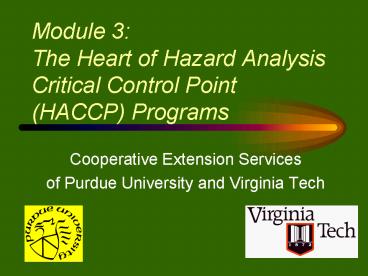Module 3: The Heart of Hazard Analysis Critical Control Point HACCP Programs - PowerPoint PPT Presentation
1 / 10
Title:
Module 3: The Heart of Hazard Analysis Critical Control Point HACCP Programs
Description:
The goal of HACCP is to prevent and/or minimize risks associated with biological, ... FDA - HACCP regulations for inspection of seafood products ... – PowerPoint PPT presentation
Number of Views:245
Avg rating:3.0/5.0
Title: Module 3: The Heart of Hazard Analysis Critical Control Point HACCP Programs
1
Module 3The Heart of Hazard Analysis Critical
Control Point (HACCP) Programs
- Cooperative Extension Services
- of Purdue University and Virginia Tech
2
Food Safety and HACCP
- The purpose of HACCP is to help ensure the
production of safe food - The goal of HACCP is to prevent and/or minimize
risks associated with biological, chemical, and
physical hazards... to acceptable levels - It is based on PREVENTION rather than detection
of hazards
3
History of HACCP
- Pioneered in the 1960s
- First used for the space program - Pillsbury and
NASA - Adopted by many food processors and the U.S.
government
4
Uses of HACCP?
- A farm-to-the-fork approach
- On-farm agriculture
- Transportation
- Food preparation handling
- Food processing
- Meat and poultry regulations
- Seafood regulations
- Food service
- Consumer handling use
5
HACCP Regulations
- USDA - HACCP regulations for meat and poultry
slaughter and processing
Pathogen Reduction Act - FDA - HACCP regulations for inspection of seafood
products - FDA requirements for fruit juice that is not
heat-processed
6
Steps of HACCP
- 1. Organize a HACCP team
- 2. Describe the product, ingredients, and the
process - 3. Develop a HACCP flow diagram for
- each product
- 4. Perform the 7 principles of HACCP
- 5. Train employees how to implement
- HACCP properly
7
HACCP Principles
- 1. Identify hazards
- 2. Determine Critical Control Points (CCPs)
- 3. Determine safety limits for CCPs
- 4. Monitor CCPs
- 5. Corrective action
- 6. Record data
- 7. Verify that the system is working
8
The Heart of HACCP
- Monitoring CCPs
- Time/Temperature devices
- Thermometers
- Separation devices
- filters, screens
9
The Heart of HACCP
- Record Keeping
- Who records the data?
- How often?
- What do you do if the data is not what it should
be? - Who checks the data?
10
Examples of HACCP
Implementation Of HACCP

